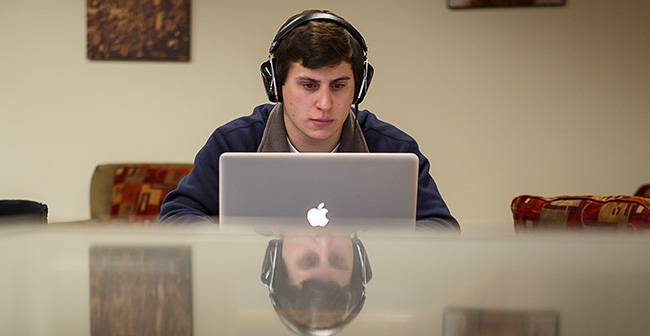You have /5 articles left.
Sign up for a free account or log in.

Moravian College
If you were drawing up a list of American colleges and universities that boast the fastest Internet speeds, chances are that prestigious research institutes and technology institutes would rank high. How likely is it that Moravian College, a small liberal arts college in Bethlehem, Pa., would make that list?
Moravian is halfway into a transformation that college officials say will “level the playing field” technologically, putting laptops and tablets in the hands of all students and connecting them to a wireless network capable of speeds most of them will never need. At the same time, faculty members are exploring how the multimillion-dollar investments in hardware fit into the college’s centuries-long history as a seminary and liberal arts institution.
Some, like the college's president, Bryon L. Grigsby, envision moving to a “cradle to grave” model of education. According to that model, Moravian will increase its residential undergraduate population, expand its lineup of graduate programs and, beyond that, offer working adults short, skill-based courses to keep them coming back after graduation. Laptops and tablets, he said, can help the college move in that direction.
“My vision for Moravian would be a place where it truly took alma mater -- ‘soul mother’ -- seriously and said to its alums, ‘Wherever you are in your career path, we will be ready with the next upgrade to the content you need in whatever delivery fashion you would like it,” Grigsby said in an interview. “It’s shortsighted to think of yourself as only serving 18- to 22-year-olds in a residential environment. … You can be a fantastic residential liberal arts college and also have graduate programs and stackable credentials that serve the greater community. I’m always struck by these ‘either-or’ statements that you see quite often. You can be ‘and.’”
Grigsby graduated from Moravian in 1990 and returned as president in 2013. In one of his first moves, he proposed and won support for a program that ensures that each freshman receives a laptop and a tablet from Apple. In anticipation of thousands of new devices connecting to the campus network, the college also spent $2.4 million to upgrade its wireless infrastructure.
Grigsby said the initiatives are meant both as an equalizer and to further the college’s mission. First-generation students make up nearly one-quarter of Moravian’s undergraduate enrollment. Supplying them with laptops and tablets means all students have an opportunity to familiarize themselves with the technology they will be using daily in their careers, he said.
“Technology is just like any of the other liberal arts skills that we want to provide our students,” Grigsby said, listing it alongside critical thinking, communication and collaboration as skills that liberal arts colleges have a responsibility to promote in their students. Colleges, he added, have “given up that responsibility by saying [students] just know how to do this because they’re ‘digital natives.’ I don’t want to give up that responsibility.”
By fall 2017, the device program will cover all of Moravian’s roughly 1,730 undergraduates, and the network may reach its target speed of one gigabit per second (in other words, capable of everyone on campus streaming about 40 movies and TV shows from Netflix in “ultra-HD” quality at the same time). At that point, said Scott C. Hughes, the college’s chief information officer, “we’re going to take a look at how we redefine the classroom.”
That debate, when it arrives in a couple of years, won't be painless. The role of technology in the classroom continues to be a hot topic of debate in higher education, and faculty at many colleges have opposed what they see as top-down approaches by administrators.
“There’s always going to be pushback against stuff that’s seen as new,” Grigsby said but added, “You cannot be 20 years old and choose not to engage in technology and truly be successful, I believe.”
Hughes stressed Moravian is not looking to use technology to rapidly enroll thousands more students than it does today (the college’s strategic plan aims for 2,000 undergraduates by 2020). Instead, the investments in technology are an attempt by the college to “keep up with 21st-century expectations” -- in other words, the idea that a college should offer faster Internet speeds than students see at home, he said.
“If you choose not to follow technology, you just signed your own death sentence,” Hughes said. “We’re going to get into online education, hybrid learning, but we’re going to figure out how to wrap it around a liberal arts core.”
An early example of such an initiative is launching next spring in the department of economics and business. Gary Kaskowitz, associate professor and department chairman, will teach what could be the first of a new type of educational offering from Moravian -- a one-credit-hour, skills-based course module in sales aimed at alumni interested in adding new knowledge on top of existing degrees.
“There are a lot of people out there who graduate with whatever degree and go out into the workforce and realize they might need a skill or two they didn’t have in their undergraduate education,” Kaskowitz said in an interview. “A stackable credential is a way to get at that.”
The module is essentially one-third of an M.B.A. course, Kaskowitz said. While a full course takes eight or nine weeks to complete, students could finish the module in three and pay about one-third of the price, he said. If a student completes three modules, he or she could potentially take an exam and have them count as credit toward an M.B.A., he said. Those details may change as the college continues to experiment.
The spring pilot will be taught in face-to-face and hybrid settings as instructors “get the kinks worked out,” Kaskowitz said. Moravian may offer a fully online version in the future. From there, it could expand to other departments, he said.
At the undergraduate level, faculty members will be encouraged to flip their classrooms -- moving lectures online to free up class time for hands-on activities -- to take advantage of the new devices. To prepare students for online education, the college may in the future require upperclassmen to take an online course, Grigsby said.
“Part of our new vision statement is the notion of education for everybody,” Kaskowitz said. “Our mission is to prepare you for a life or career that probably doesn’t exist yet.”




